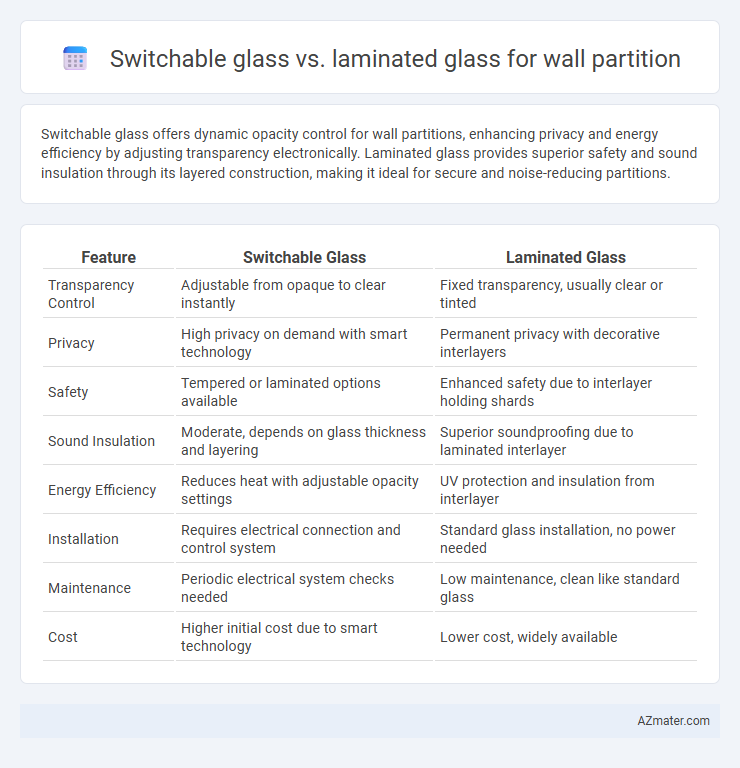Switchable glass offers dynamic opacity control for wall partitions, enhancing privacy and energy efficiency by adjusting transparency electronically. Laminated glass provides superior safety and sound insulation through its layered construction, making it ideal for secure and noise-reducing partitions.
Table of Comparison
| Feature | Switchable Glass | Laminated Glass |
|---|---|---|
| Transparency Control | Adjustable from opaque to clear instantly | Fixed transparency, usually clear or tinted |
| Privacy | High privacy on demand with smart technology | Permanent privacy with decorative interlayers |
| Safety | Tempered or laminated options available | Enhanced safety due to interlayer holding shards |
| Sound Insulation | Moderate, depends on glass thickness and layering | Superior soundproofing due to laminated interlayer |
| Energy Efficiency | Reduces heat with adjustable opacity settings | UV protection and insulation from interlayer |
| Installation | Requires electrical connection and control system | Standard glass installation, no power needed |
| Maintenance | Periodic electrical system checks needed | Low maintenance, clean like standard glass |
| Cost | Higher initial cost due to smart technology | Lower cost, widely available |
Introduction to Wall Partition Glass Solutions
Wall partition glass solutions offer versatile options such as switchable glass and laminated glass, each enhancing space functionality and privacy differently. Switchable glass utilizes smart technology to toggle between transparent and opaque states, ideal for dynamic privacy control in offices and conference rooms. Laminated glass provides safety and sound insulation by layering glass with interlayers, making it suitable for secure and durable wall partitions in commercial and residential environments.
What is Switchable Glass?
Switchable glass, also known as smart glass, is an innovative material that changes from opaque to transparent with the application of an electrical current, providing privacy on demand for wall partitions. Unlike laminated glass, which consists of multiple glass layers bonded with an interlayer for safety and sound insulation, switchable glass offers dynamic control over light and visibility without compromising structural integrity. Its technology benefits office spaces and commercial interiors by combining functionality and modern aesthetics, optimizing energy efficiency and space utilization.
What is Laminated Glass?
Laminated glass consists of two or more glass layers bonded with an interlayer, typically made of polyvinyl butyral (PVB), enhancing safety and sound insulation in wall partitions. This construction ensures that if the glass breaks, shards adhere to the interlayer, preventing dangerous splinters and maintaining structural integrity. Compared to switchable glass, laminated glass offers superior impact resistance and privacy without the need for electrical control.
Key Differences: Switchable vs. Laminated Glass
Switchable glass offers dynamic opacity control by using an electric current to change from transparent to frosted, providing privacy on demand in wall partitions. Laminated glass consists of two or more layers of glass bonded with an interlayer, enhancing safety and sound insulation but remaining permanently transparent or frosted. Switchable glass excels in versatility and privacy control, while laminated glass prioritizes structural strength and impact resistance for wall partition applications.
Light Control and Privacy Features
Switchable glass for wall partitions offers instant control over light transmission by electronically toggling between opaque and transparent states, ensuring privacy on demand without compromising natural light. Laminated glass provides consistent privacy through its multi-layered construction, which includes an interlayer that enhances safety and sound insulation but lacks dynamic light control. For environments requiring flexible light adjustment and privacy, switchable glass outperforms laminated glass by delivering customizable transparency while laminated glass is better suited for permanent privacy and structural reinforcement.
Acoustic Performance Comparison
Switchable glass offers moderate sound insulation by electronically controlling opacity but generally underperforms compared to laminated glass in acoustic dampening. Laminated glass, composed of multiple layers with a polyvinyl butyral (PVB) interlayer, excels in reducing noise transmission, making it ideal for wall partitions requiring high soundproofing. Acoustic performance metrics such as Sound Transmission Class (STC) ratings consistently favor laminated glass, providing superior noise reduction for office and commercial environments.
Safety and Security Considerations
Switchable glass enhances privacy by instantly changing from transparent to opaque, offering strong visual security but limited physical impact resistance compared to laminated glass. Laminated glass consists of multiple layers bonded with a plastic interlayer that holds shards together upon breakage, providing superior protection against forced entry and reducing injury risk. For wall partitions, laminated glass is preferred in high-security environments due to its shatter-resistant properties, while switchable glass suits areas prioritizing privacy without compromising on basic safety.
Energy Efficiency and Sustainability
Switchable glass offers superior energy efficiency by dynamically controlling light transmission and reducing heat gain, which lowers HVAC energy consumption compared to laminated glass. Laminated glass, while providing excellent sound insulation and safety benefits, has limited impact on energy savings due to its fixed transparency. For sustainable wall partitions, switchable glass reduces reliance on artificial lighting and temperature control, promoting lower carbon footprints in commercial and residential buildings.
Cost Analysis and Installation Factors
Switchable glass for wall partitions typically incurs higher upfront costs compared to laminated glass due to advanced technology and electrical components required, impacting initial budget considerations. Installation of switchable glass demands skilled labor for wiring and integration with power sources, often extending project timelines, whereas laminated glass benefits from simpler, faster installation with standard framing techniques. Long-term cost analysis favors laminated glass for lower maintenance and energy consumption, while switchable glass adds value through privacy control and modern aesthetics suitable for premium office or commercial environments.
Choosing the Right Glass for Your Space
Switchable glass offers dynamic privacy control by transitioning from opaque to transparent with electric current, ideal for adaptable office partitions requiring instant privacy. Laminated glass provides enhanced safety and sound insulation due to its bonded interlayer, making it suitable for high-traffic or noise-sensitive wall partitions. Selecting between switchable and laminated glass depends on your priorities for privacy, safety, and acoustic performance within your space.

Infographic: Switchable glass vs Laminated glass for Wall partition
 azmater.com
azmater.com